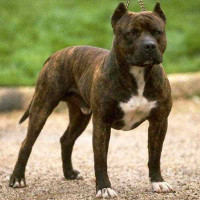Appearance of the Pitsky
|
| Hybrid dogs, especially those that haven't been around very long, can vary enormously in appearance from litter to litter. This is especially true for the Pitsky if the mix includes the Alaskan Husky, which is a breed with an already highly varied physical appearance. Developed from two naturally athletic breeds, it was inevitable that the Pitsky would have a strong, muscular body. Although the Husky and Pit bull are athletes in their own right, they were bred for very different purposes and have totally different body shapes. First-generation Pitskys may take more after their lean, long-limbed Husky parent, or they may look more like the sturdy, stocky Pit-bull. Ears can be erect, droopy or somewhere in between. Although their eyes are the popular piercing blue color associated with Huskies, they can also be brown or green, and it's not uncommon to have one eye colored differently (heterochromia). The tail within this breed is particularly variable, with some puppies having a long-haired, spiny tail that curves over the back and others having a low, less erect tail. The Pitsky's coat can be a single or double coat, and there is a wide range of potential coat colors, including black, white, red, gray, fawn and brindle. A mixture of a few color combinations is frequently seen, and there are an almost unlimited number of possible patterns and markings. Males generally measure between 43 and 56 centimeters, while smaller females measure between 40 and 53 centimeters. Males weigh between 22 and 29 kilos, and females are usually a few kilos lighter, between 20 and 27 kilos. |
Temperament of the Pitsky
|
| A dog with energy to spare, Pitskies don't tend to have a Stop button. A breed that would happily run 10 km before joining you for a game of soccer, the Pitsky is ideally suited to a very active family who can provide them with plenty of space and outdoor access. Loving and affectionate, Pitskies tend to bond closely with their families and will get on well with children at home as long as they've been introduced to them from an early age. Of course, with such a powerful dog, young children will need constant supervision and must learn to respect the family dog. The close bonds these dogs form with their family members can pose a problem for some dogs who become too attached. Pitskies should not be housed where they will be left alone for long periods. Some Pitsky dogs can be very tense and hyper tense and will need solid training to stay on track. When it comes to mixing with other animals, caution is recommended. Dog-to-dog aggression is a possibility, especially with two undisturbed males. Similarly, smaller pets are at risk, as the Pitsky has a strong prey drive. |
Needs and activities of the Pitsky
|
| The Pitsky cross is a very athletic animal and requires plenty of exercise every day, usually at least an hour and a half of vigorous or strength-building exercise, although most prefer two hours or more. Goblins that don't get enough daily exercise and attention can become both destructive and vocal, sometimes even howling in frustration. Fortunately, these high-energy dogs also possess many talents and can enjoy and even excel at many types of activity. In addition to long walks, jogging and running, these dogs can also enjoy sports such as Frisbee competitions, sled shooting or skijoring and agility training. |
Maintenance of the Pitsky
|
| Grooming requirements for this dog will vary according to the coat characteristics it may have inherited. Bathing may be infrequent with either coat, but if your dog has inherited the Husky's thick undercoat, it's particularly important to ensure that this layer is completely dry to prevent mold growth. Both coats require regular brushing, but the longer coat, like that of the Husky, will require more frequent brushing, usually daily, while the shorter coat of the Pit Bull can be treated with weekly brushing. This hybrid will shed quite heavily, although short-haired dogs may shed more moderately than long-haired ones. |









 English (United Kingdom)
English (United Kingdom)